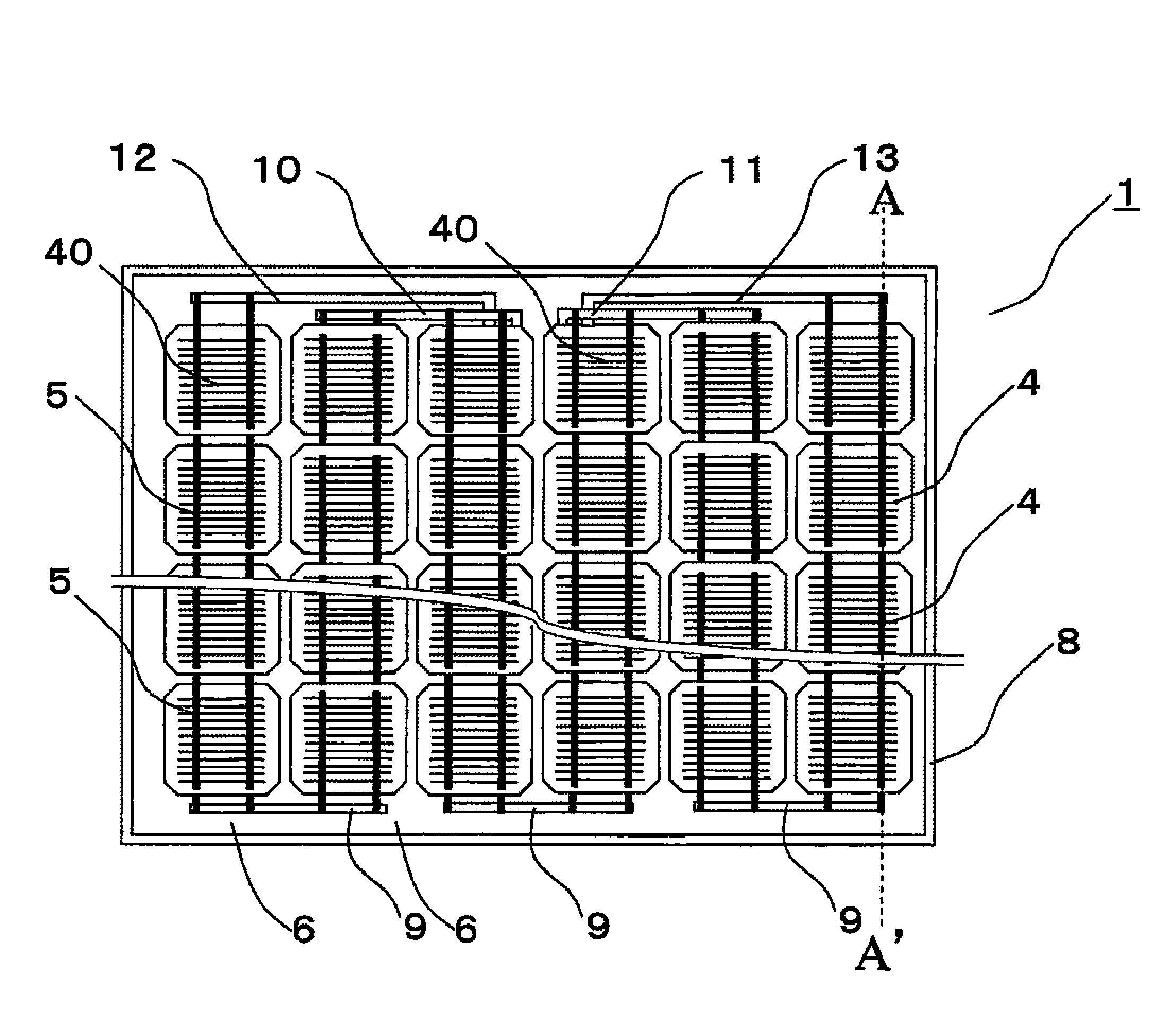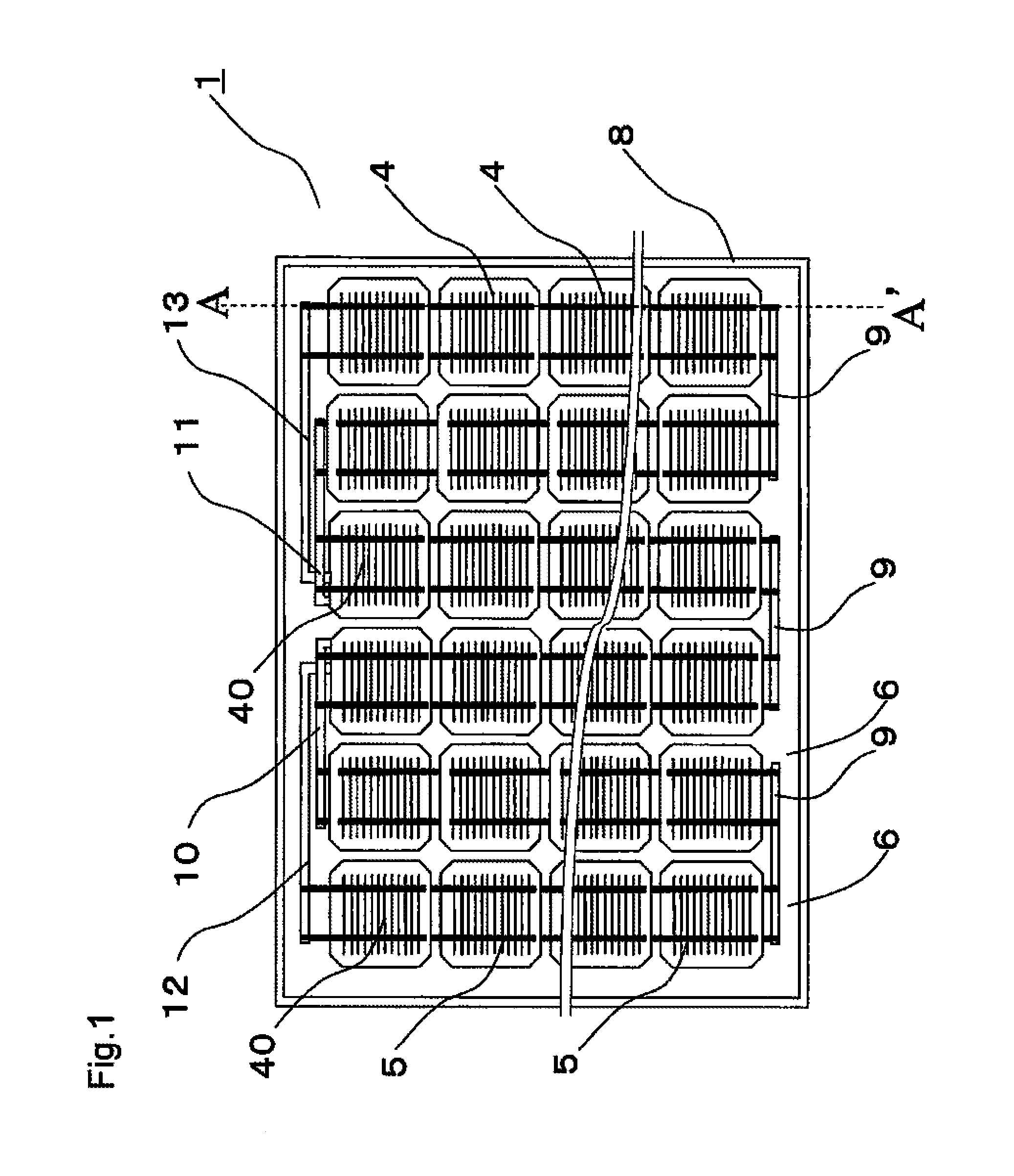Solar cell, solar cell module and solar cell system
a solar cell and module technology, applied in the field of solar cells, can solve the problems of low production yield of solar cells, high cost, easy cracking of substrates, etc., and achieve the effect of improving production yield
- Summary
- Abstract
- Description
- Claims
- Application Information
AI Technical Summary
Benefits of technology
Problems solved by technology
Method used
Image
Examples
first embodiment
[0048]A solar cell module including a plurality of solar cells according to a first embodiment of the invention is described with reference to FIGS. 1 to 6B. FIG. 1 is a top view of the solar cell module according to the first embodiment of the invention. FIG. 2 is a perspective view of the solar cell module. FIG. 3 is a partial cross-sectional view taken along the line A-A′ of FIG. 1. FIG. 4A is a top view of the solar cell of the solar cell module of FIG. 1. FIG. 4B is a bottom view of the solar cell. FIG. 5A is a front side plan view provided for describing the connection between the solar cell and conductive connection members. FIG. 5B is a partial schematic cross-sectional view taken along the line A-A′ of FIG. 5A. FIG. 6A is a partial schematic cross-sectional view taken along the line B-B′ of FIG. 5A. FIG. 6B is a partial schematic cross-sectional view taken along the line C-C′ of FIG. 5A.
[0049]As shown in FIGS. 1 through 3, solar cell module 1 includes a rectangular plate-li...
second embodiment
[0087]A solar cell module according to a second embodiment of the invention is described with reference to FIGS. 8A and 8B. FIG. 8A is a top view of a solar cell in the solar cell module according to this embodiment. FIG. 8B is a bottom view of the solar cell. Here, differences from the first embodiment are mainly described.
[0088]Referring to FIGS. 8A and 8B, each of solar cells 4 has front surface electrode 40 including a plurality of narrow linear finger electrodes 40a disposed on the front surface thereof so as to cover substantially the entire front surface region, and two narrow saw-tooth like bus bar electrodes 140b connected to the plurality of narrow finger electrodes 40a. In addition, each of solar cells 4 has rear surface electrode 41 including a plurality of narrow linear finger electrodes 41a disposed on the rear surface thereof so as to cover substantially the entire rear surface region, and two narrow saw-tooth like bus bar electrodes 141b connected to the plurality of...
third embodiment
[0098]A solar cell module according to a third embodiment of the invention is described with reference to FIGS. 9A and 9B. FIG. 9A is a top view of a solar cell in the solar cell module according to this embodiment. FIG. 9B is a bottom view of the solar cell. Here, differences from the first embodiment are mainly described.
[0099]Referring to FIGS. 9A and 9B, each of solar cells 4 has front surface electrode 40 including a plurality of narrow linear finger electrodes 40a disposed on the front surface thereof so as to cover substantially the entire front surface region, and two narrow wave like bus bar electrodes 240b connected to the plurality of narrow linear finger electrodes 40a. Each narrow linear finger electrode 40a has width Wf equal to 60 μm, and each narrow wave like bus bar electrode 240b has width W equal to 1.5 mm, for example. In addition, each of solar cells 4 has rear surface electrode 41 including a plurality of narrow linear finger electrodes 41a disposed on the rear...
PUM
 Login to View More
Login to View More Abstract
Description
Claims
Application Information
 Login to View More
Login to View More - R&D
- Intellectual Property
- Life Sciences
- Materials
- Tech Scout
- Unparalleled Data Quality
- Higher Quality Content
- 60% Fewer Hallucinations
Browse by: Latest US Patents, China's latest patents, Technical Efficacy Thesaurus, Application Domain, Technology Topic, Popular Technical Reports.
© 2025 PatSnap. All rights reserved.Legal|Privacy policy|Modern Slavery Act Transparency Statement|Sitemap|About US| Contact US: help@patsnap.com



